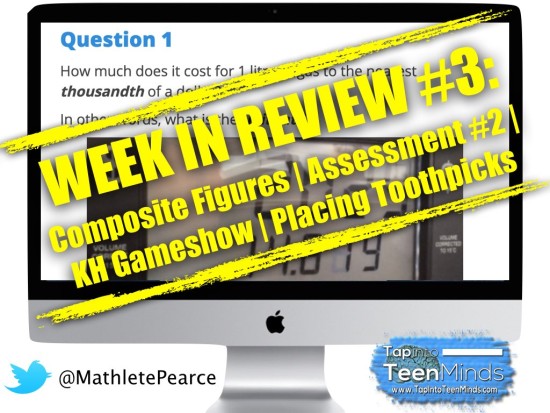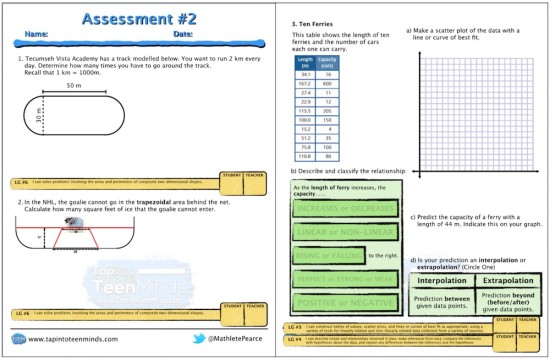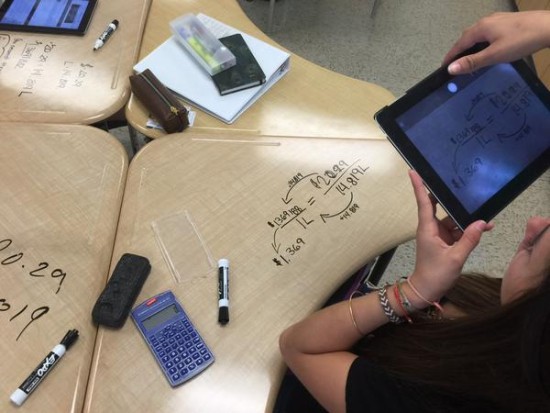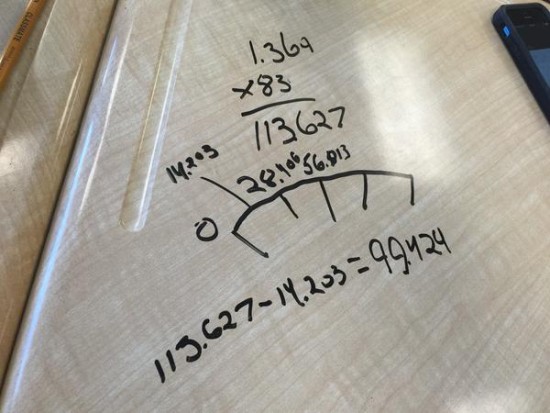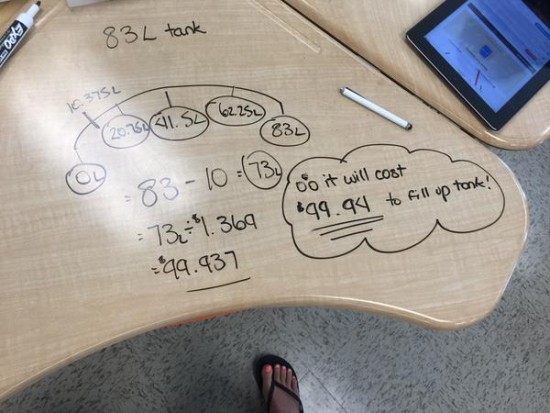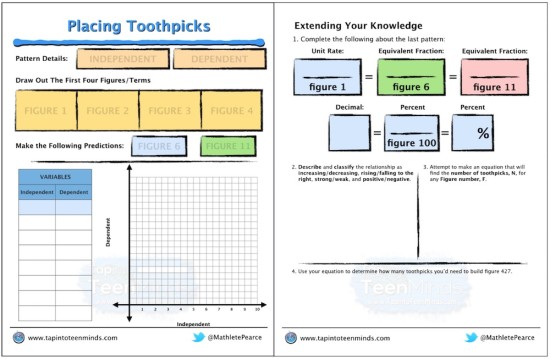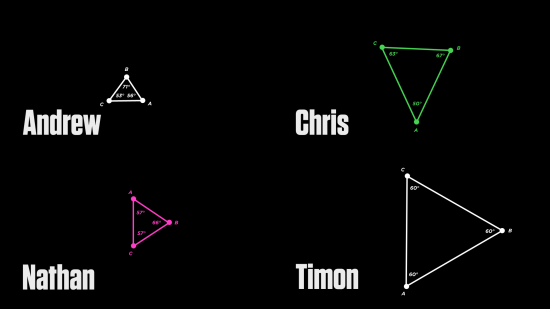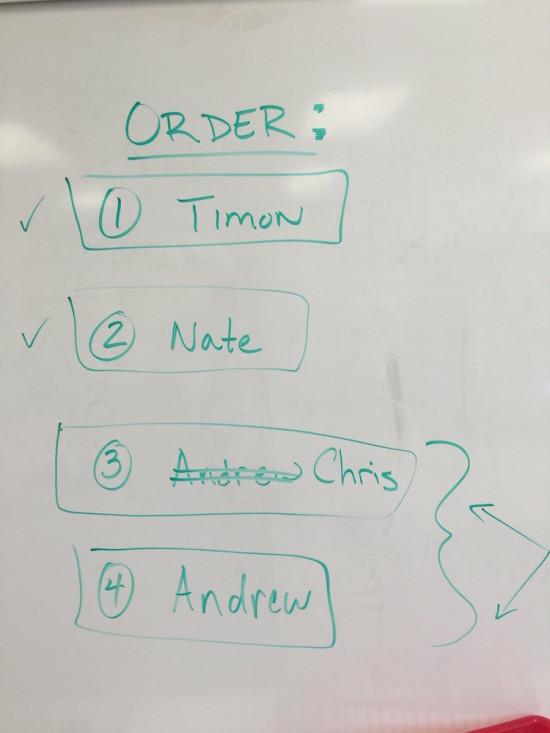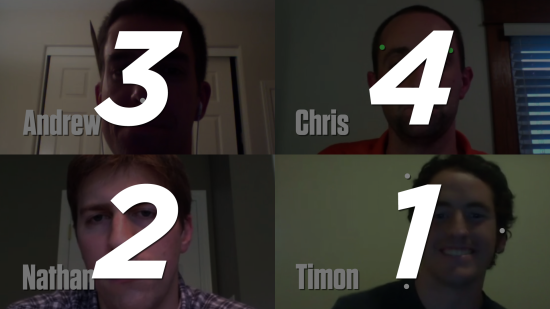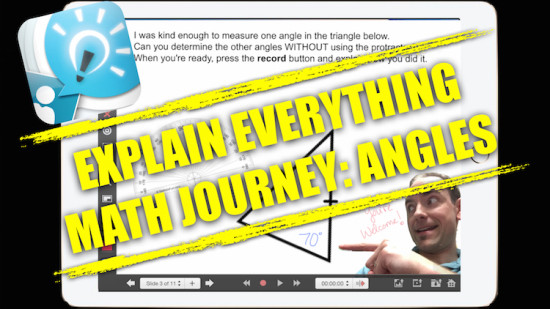A Weekly Summary of My Math Classroom
September 21st to 25th, 2015
Day #10 – Monday September 21st, 2015
Composite Figures Practice
Today, I had intended to use a Knowledgehook Gameshow as a warm-up related to area of composite figures and then move into the Gas Guzzler 3 Act Math Task. Unfortunately, my timing was completely off as I had 7 questions and some students who were pretty eager to solve them with their complete solutions uploaded to the system (bonus!).
Here’s the gameshow that we used:
Can’t see the Gameshow on the page? Click here.
By the time we tackled each problem while sharing student solutions over the projector using the “Share Solution” feature as we went, we had 15 minutes remaining in class. Definitely not enough time to tackle what I had planned for Gas Guzzler.
Instead, I assigned an activity related to linear correlation via Knowledgehook Homework mode and students were off to the races.
Tomorrow, we will have Assessment #2 to see how we are making out thus far with our learning goals that we have covered.
Day #11 – Tuesday September 22nd, 2015
Assessment #2 – Measurement of Composite Figures & Linear Relationships
Tuesday is Assessment day where I take a few questions from any learning goal from the year to see what point students are at in their learning. Students are not told what they will see prior to the assessment, but also know that the purpose is to promote growth, not cement marks into a grade book. If students struggle on a concept, now they know what to look at for the following week and can submit work from given “Growth Opportunities” from their online Learning Logs. Students are also permitted and encouraged to create their own “Growth Opportunities” to improve.
Assessment #2 will cover the following learning goals:
- I can solve problems involving the areas and perimeters of composite two-dimensional shapes.
- I can construct tables of values, scatter plots, and lines or curves of best fit as appropriate, using a variety of tools for linearly related and non-linearly related data collected from a variety of sources.
- I can describe trends and relationships observed in data, make inferences from data, compare the inferences with hypotheses about the data, and explain any differences between the inferences and the hypotheses.
We will also introduce, for the first time, a new learning goal:
- I can determine values of a linear relation by using a table of values, by using the equation of the relation, and by interpolating or extrapolating from the graph of the relation.
Students get a little squirmy when I introduce a new concept on an assessment, however I do give enough information for them to apply the new concept. I consider this like a diagnostic to determine where students are in relation to the new concept. I simply provide students feedback on how they handled the new concept and ensure they know that the concept will begin coming up regularly in class and on future assessments.
You can check out the assessment below:
Day #12 – Wednesday September 23rd, 2015
Gas Guzzler – Proportional Reasoning Extending to Linear Relations
Today, I used the Gas Guzzler 3 Act Math Task as a way to help students build their problem solving skills while connecting proportional reasoning to direct variation linear relations.
If you’ve never come across Gas Guzzler, here’s the Act 1 Video:
Can’t see the video? Click here.
Grab the whole task here.
After watching the video, we have students share out their questions. The question I want to focus on first is:
How much does it cost per litre of gas?
We then get kids making their predictions and then I give them some more information about the task in Act 2.
Students then work in their table groups to come up with a solution prior to seeing the Act 3 video to check their answer.
For the first time this year, I decided that we could really extend this task to other learning goals we’ve covered this semester and even introduce new concepts along the way by creating a Custom Gameshow. So I started with questions pretty closely tied to proportional reasoning:
Tomorrow, I’ll do a warm-up gameshow with more questions that extend to direct variation linear relations.
Here’s some student exemplars from today:
Day #13 – Thursday September 24th, 2015
Gas Guzzler (Continued) & Placing Toothpicks – Patterning
As mentioned above, I had intentions to extend the Gas Guzzler task to direct variation linear relations by introducing initial value and rate of change. Here’s the warm-up Gameshow that I created to support the extensions:
This was the first time I’ve attempted to “embed” a new concept into practice. It seemed to work well. I attempted to define the new concepts in a question to get students to think critically about what we have introduced. Here’s one of the questions, in particular:
After we finished up the warm-up, I had the Placing Toothpicks 3 Act Math Task lined up and ready to go. Students watched this video:
After hearing the questions students had about the video, I showed them this:
Click here if you can’t see the video.
The questions I want students to think about are:
How many toothpicks are in the 6th term? … the 11th term?
I would likely have students figure this out on their own, using any strategy and then consolidate the task. The following math task template might be a good option to consolidate student thinking:
You can now let students see their solution in action!
Figure 6 Solution
Can’t see the video? Click here.
Figure 11 Solution
Can’t see the video? Click here.
Day #14 – Friday September 25th, 2015
Best Triangle & Explain Everything Angle Learning Journey
This week, the focus has been on area of composite figures, proportional reasoning and linear relations. Some areas I haven’t spiralled into yet are angle geometry, exponent laws, and algebra. When I used traditional units to teach this course, I typically left angle geometry until very late in the course. This year, I wanted to slowly introduce them early on in order to give students multiple opportunities to build a deep conceptual understanding.
To this point I have struggled to find a compelling reason for why we learn the properties of interior and exterior angles of a triangle. I know that we can apply triangles to many real world situations, but how can we hook students in to want to engage in a task requiring their use?
This time around, I decided to use Dan Meyer‘s Best Triangle 3 act math task as a way to get kids thinking about triangles and allow me to branch off into properties of interior and exterior angles.
Here’s how it went down:
Act 1 – Introduce The Task
I showed students this video:
[jwplayer mediaid=”16566″]
Can’t see the video? Click here.
The question asked in the video is:
Draw three points in the shape of an equilateral triangle.
I asked students do this on their iPads in a whiteboard app like GoodNotes 4 or Explain Everything. You’ll see why this is important later.
I then asked students to rank the triangles created by Andrew, Nathan, Chris and Timon. Who, do they believe, created the best equilateral triangle? Do they think that their triangle is better than all four?
We then had a discussion about how they could prove or disprove a claim that one triangle was “better” than another. Students were quick to recall from elementary school that equilateral triangles have equal sides, but it took a little while longer to get someone to state that the angles are also equal.
Act 2 – Reveal Some Information
At this point, I had intended to use a pre-made interactive Geogebra worksheet that has a screenshot of the four triangles so students could measure the angles. My thinking was that this would be a pretty pain-free way to introduce students to this free online resource and also serve a purpose to help us measure angles. Check out the sheet below:
Can’t see the Geogebra Worksheet? ” target=”_blank”>Click here.
Unfortunately, about half of the students had some pretty significant struggles using this web based tool on their iPad. I had no such struggles on my iPad Air 2, however my students are using 5 year old iPad 2 devices. Maybe these relatively old iPads didn’t have the processing power necessary? After an abundance of troubleshooting around the room, I wiped the sweat from my brow and finally pulled the plug on this portion of the activity. I went straight for this image to reveal the angle measures of each triangle:
At this point, I asked students to work in their table groups to come up with an agreed upon order from “Best Triangle” to “Worst Triangle” and we would share out in 3 minutes.
As a whole, we managed to come up with the following order:
- Timon
- Nate
- Chris
- Andrew
The discussion was rich as students tried to justify why they ordered Nate, Chris and Andrew the way they did. Students agreed that Andrew had the “greatest” angle and thus they felt he should be last. While they noticed that Chris had the “least” angle, they failed to make a comparison to determine what else might affect their decision.
Act 3 – Watch The Solution
Students were really surprised to see that Chris was last, but we had a good discussion as to why that made sense. While we do not explore some of the analytic geometry required to explore this task further in grade 9, I did mention to students that we could revisit this problem in grade 10 using more mathematical tools to help us come to this same conclusion.
Explain Everything Angle Learning Journey
Once we completed this task, I had students jump into the Explain Everything Angle Journey I had created for my students last year. The intention with this task was to allow students to revisit some of the concepts they have experienced in elementary school. The screencasting features of the app also allowed them to consolidate some of their learning with the interior and exterior angles of triangles while helping me determine what we need to touch upon before moving on.
If you haven’t checked out the full blog post, you can click here to jump to the post.
WANT TO LEARN HOW TO TEACH THROUGH TASK?
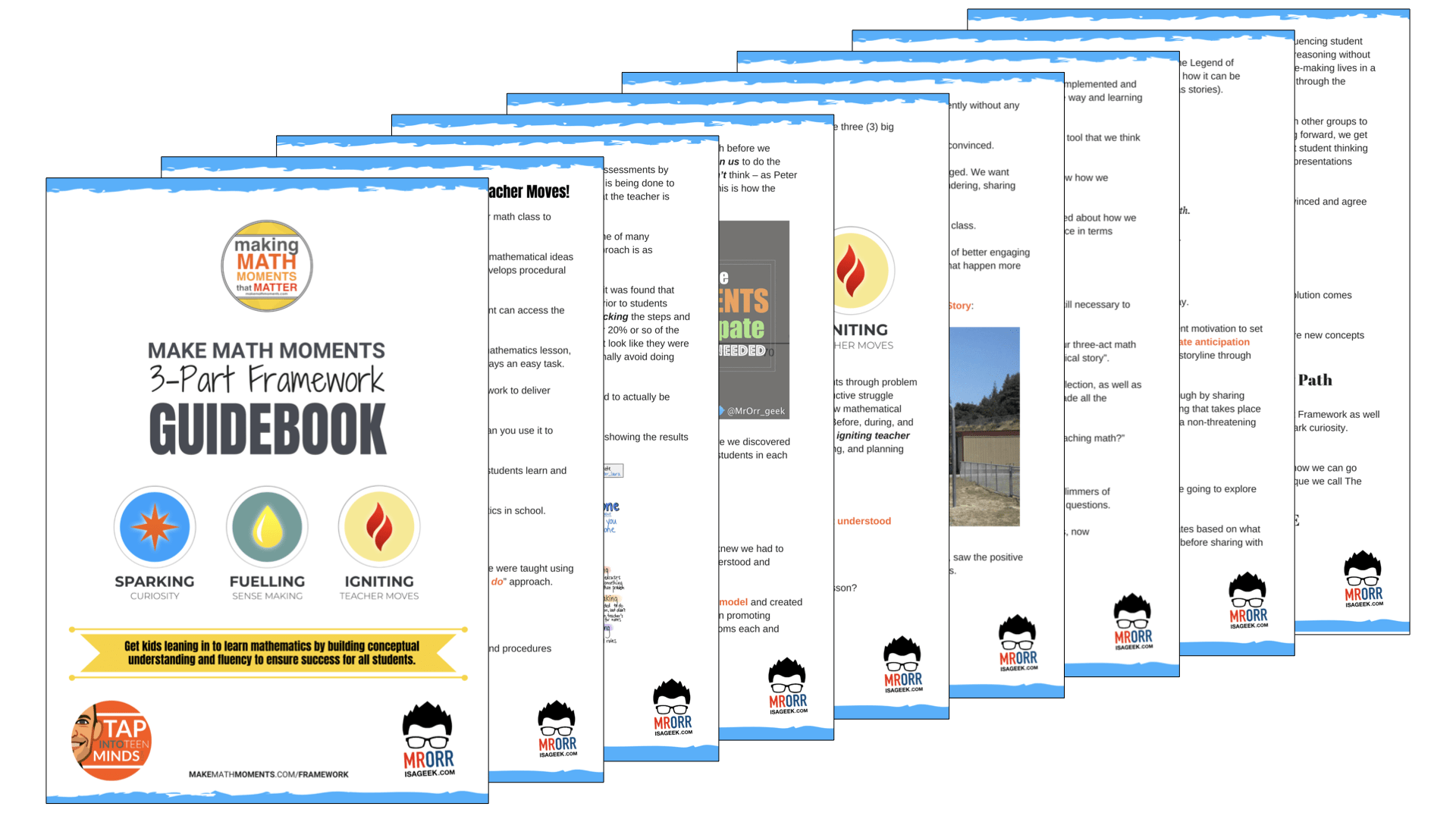
Share With Your Learning Community:

About Kyle Pearce
I’m Kyle Pearce and I am a former high school math teacher. I’m now the K-12 Mathematics Consultant with the Greater Essex County District School Board, where I uncover creative ways to spark curiosity and fuel sense making in mathematics. Read more.
Read More From The Blog

